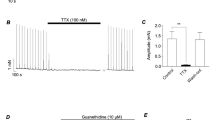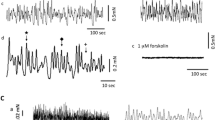Abstract
The purinergic response of the guinea-pig vas deferens to long trains of pulses at high frequency consists of an initial twitch followed by a much lower plateau. Mechanical, neurochemical and electrophysiological techniques were used to examine the reason for the fade.
Mechanical measurements. In tissues stimulated by trains of 180 pulses/10 Hz and treated with prazosin to suppress the noradrenergic contraction component, the response to α,β-methylene ATP and to exogenous ATP was as high during the secondary plateau of the purinergic neurogenic contraction as it was outside electrical stimulation periods; the response to 50 pulses/100 Hz was also unchanged during the low plateau. The plateau was not increased by reactive blue 2, 8-(p-sulphophenyl)theophylline, propranolol or capsaicin. Neurochemical measurements. In tissues preincubated with [3H]-noradrenaline, electrical stimulation elicited an overflow of tritium and of ATP. In the absence of drugs as well as in the presence of prazosin and suramin to suppress contractions, the overflow of tritium per pulse decreased slightly in the course of trains of 90 pulses/10 Hz; the overflow of ATP per pulse decreased to a greater extent on average, but the decrease was not statistically significant. In the presence of prazosin and nifedipine, also to suppress contractions, the overflow of tritium per pulse again decreased slightly in the course of trains of 105 pulses/10 Hz, but the overflow of ATP per pulse if anything tended to increase. Electrophysiological measurements. Extracellular recording in the presence of prazosin showed that electrical stimulation by 180 pulses/10 Hz elicited excitatory junction currents (EJCs) which facilitated and summated to reach threshold for the initiation of action potentials in the smooth muscle cells. In most tissues, smooth muscle action potentials ceased after a few seconds although EJCs continued. Intracellular recording in the presence of prazosin and nifedipine showed that excitatory junction potentials (EJPs) elicited by 180 pulses/10 Hz facilitated and summated to a plateau after about 10 stimuli. The EJPs continued unchanged, and the plateau depolarization was maintained, throughout the train.
It is concluded that the fade of the purinergic neurogenic contraction is not due to P2Y-purinoceptor desensitization. It also is not due to a secondary relaxation mediated by P2Y- or P1-purinoceptors, β-adrenoceptors or a compound originating from primary afferent axons. Moreover, a fade of the release of ATP in the course of the pulse train is not responsible for the contraction fade. Rather, the reason is a failure of the process by which the smooth muscle cell depolarization triggers action potentials. Inactivation of l-type Ca2+ channels that are under the control of released ATP may be the underlying mechanism.
Similar content being viewed by others
References
Allcorn RJ, Cunnane TC, Kirkpatrick K (1986) Actions of α, β-methylene ATP and 6-hydroxydopamine on sympathetic neurotransmission in the vas deferens of the guinea-pig, rat and mouse: support for co-transmission. Br J Pharmacol 89:647–659
Ambache N, Zar MA (1971) Evidence against adrenergic motor transmission in the guinea-pig vas deferens. J Physiol 216:359–389
Amobi NIB, Smith ICH (1987) A study of the post-tetanic twitch depression at the prostatic end of the rat vas deferens. Pflügers Arch 408:628–633
Bao JX, Gonon F, Stjärne L (1993) Kinetics of ATP- and noradrenaline-mediated sympathetic neuromuscular transmission in rat tail artery. Acta Physiol Scand 149:503–519
Barthó L, Szolcsdnyi J (1978) The site of action of capsaicin on the guinea-pig isolated ileum. Naunyn-Schmiedeberg's Arch Pharmacol 305:75–81
Bean BB (1989) Classes of calcium channels in vertebrate cells. Annu Rev Physiol 51:367–384
Bennett MR (1973) An electrophysiological analysis of the storage and release of noradrenaline at sympathetic nerve terminals. J Physiol 229:515–531
Blakeley AGH, Brown DA, Cunnane TC, French AM, McGrath JC, Scott NC (1981) Effects of nifedipine on electrical and mechanical responses of rat and guinea pig vas deferens. Nature 294:759–761
Boland B, Himpens B, Vincent MF, Gillis JM, Casteels R (1992) ATP activates P2X-contracting and P2Y-relaxing purinoceptors in the smooth muscle of mouse vas deferens. Br J Pharmacol 107: 1152–1158
Bourreau JP, Zhang ZD, Low AM, Kwan CY, Daniel EE (1991) Ryanodine and the adrenergic, purinergic stimulation in the rat vas deferens smooth muscle: functional and radioligand binding studies. J Pharmacol Exp Ther 256:1063–1071
Brock JA, Cunnane TC (1988) Studies on the mode of action of bretylium and guanethidine in post-ganglionic sympathetic nerve fibres. Naunyn-Schmiedeberg's Arch Pharmacol 338:504–509
Brock JA, Cunnane TC (1992) Impulse conduction in sympathetic nerve terminals in the guinea-pig vas deferens and the role of the pelvic ganglia. Neuroscience 47:185–196
Bültmann R, Starke K (1994) P2-purinoceptor antagonists discriminate three contraction-mediating receptors for ATP in rat vas deferens. Naunyn-Schmiedeberg's Arch Pharmacol 349:74–80
Bültmann R, von Kügelgen I, Starke K (1993) Effects of nifedipine and ryanodine on adrenergic neurogenic contractions of rat vas deferens: evidence for a pulse-to-pulse change in Ca2+ sources. Br J Pharmacol 108:1062–1070
Burnstock G (1990) Co-transmission. Arch Int Pharmacodyn 304:7–33
Burnstock G, Kennedy C (1985) Is there a basis for distinguishing two types of P2-purinoceptor? Gen Pharmacol 16:433–440
Cunnane TC, Stjarne L (1984) Transmitter secretion from individual varicosities of guinea-pig and mouse vas deferens: highly intermittent and monoquantal. Neuroscience 13:1–20
Driessen B, von Kügelgen I, Starke K (1993a) Neural ATP release and its α2-adrenoceptor-mediated modulation in guinea-pig vas deferens. Naunyn-Schmiedeberg's Arch Pharmacol 348:358–366
Driessen B, Bültmann R, von Kügelgen I, Starke K (1993b) Effect of opioid receptor subtype-selective agonists on purinergic and adrenergic components of neurogenic contractions of mouse vas deferens. Br J Pharmacol 108:443–447
Ebong OO, Zar MA (1989) Failure of non-adrenergic transmission in the rat vas deferens. Neuropharmacology 28:335–341
Ellis JL, Burnstock G (1989) Modulation of neurotransmission in the guinea-pig vas deferens by capsaicin: involvement of calcitonin gene-related peptide and substance P. Br J Pharmacol 98:707–713
Elrick DB, Cunnane TC (1994) Frequency-dependent facilitation of neurotransmitter release from sympathetic nerve terminals. J Auton Pharmacol 14:17
Fedan JS, Lamport SJ (1990) P2-purinoceptor antagonists. Ann NY Acad Sci 603:182–197
Fredholm BB, Hedqvist P (1978) Release of 3H-purines from [3H]-adenine labelled rabbit kidney following sympathetic nerve stimulation, and its inhibition by α-adrenoceptor blockade. Br J Pharmacol 64:239–245
Hedler L, Stamm G, Weitzell R, Starke K (1981) Functional characterization of central α-adrenoceptors by yohimbine diastereomers. Eur J Pharmacol 70:43–52
Hedqvist P, von Euler US (1976) Inhibition by α- and β-adrenoceptors of the twitch response to transmural stimulation in the guinea-pig vas deferens. Eur J Pharmacol 40:153–162
Holzer P (1991) Capsaicin: cellular targets, mechanisms of action, and selectivity for thin sensory neurons. Pharmacol Rev 43:143–201
Hourani SMO, Nicholls J, Lee, BSS, Halfhide EJ, Kitchen I (1993) Characterization and ontogeny of P1-purinoceptors on rat vas deferens. Br J Pharmacol 108:754–758
Hoyle CHV (1992) Transmission: purines. In: Burnstock G, Hoyle CHV (eds) Autonomic neuroeffector mechanisms. Harwood Academic Publishers, Chur, Reading, Paris, pp 367–407
Király E, Jancsó G, Hajós M (1991) Possible morphological correlates of capsaicin desensitization. Brain Res 540:279–282
Limberger N, Trendelenburg AU, Starke K (1992) Pharmacological characterization of presynaptic α2-autoreceptors in rat submaxillary gland and heart atrium. Br J Pharmacol 107:246–255
MacKenzie I, Manzini S, Burnstock G (1988) Regulation of voltage-dependent excitatory responses to α, β-methylene ATP, ATP and non-adrenergic nerve stimulation by dihydropyridines in the guinea-pig vas deferens. Neuroscience 27:317–332
Maggi CA, Giuliani S, Santicioli P, Meli A (1987) Capsaicin-induced inhibition of motility of the rat isolated vas deferens: do multiple neuropeptides mediate the visceromotor effects of capsaicin? J Auton Pharmacol 7:243–255
Meldrum LA, Burnstock G (1983) Evidence that ATP acts as a co-transmitter with noradrenaline in sympathetic nerves supplying the guinea-pig vas deferens. Eur J Pharmacol 92:161–163
Msghina M, Stjarne L (1993) Sympathetic transmitter release in rat tail artery and mouse vas deferens: facilitation and depression during high frequency stimulation. Neurosci Lett 155:37–41
Msghina M, Mermet C, Gonon F, Stjärne L (1992) Electrophysiological and electrochemical analysis of the secretion of ATP and noradrenaline from the sympathetic nerves in rat tail artery: effects of α2-adrenoceptor agonists and antagonists and noradrenaline reuptake blockers. Naunyn-Schmiedeberg's Arch Pharmacol 346: 173–186
Rump LC, von Kügelgen I (1994) A study of ATP as a sympathetic cotransmitter in human saphenous vein. Br J Pharmacol 111:65–72
Shimodan M, Sunano S (1981) The initiation of phasic and tonic contraction by potassium and the effect of calcium, multivalent cations and Ca-antagonist on potassium contracture in guinea-pig vas deferens. Jpn J Physiol 31:15–27
Sneddon P, Westfall DP (1984) Pharmacological evidence that adenosine triphosphate and noradrenaline are co-transmitters in the guinea-pig vas deferens. J Physiol 347:561–580
Sneddon P, Westfall DP, Fedan JS (1982) Cotransmitters in the motor nerves of the guinea pig vas deferens: electrophysiological evidence. Science 218:693–695
Sneddon P, Meldrum LA, Burnstock G (1984) Control of transmitter release in guinea-pig vas deferens by prejunctional P1-purinoceptors. Eur J Pharmacol 105:293–299
Starke K (1977) Regulation of noradrenaline release by presynaptic receptor systems. Rev Physiol Biochem Pharmacol 77:1–124
Stjärne L, Åstrand P (1985) Relative pre- and postjunctional roles of noradrenaline and adenosine 5′-triphosphate as neurotransmitters of the sympathetic nerves of guinea-pig and mouse vas deferens. Neuroscience 14:929–946
Swedin G (1971) Studies on neurotransmission mechanisms in the rat and guinea-pig vas deferens. Acta Physiol Scand 83 [Suppl 369]: 1–34
Trendelenburg AU, Limberger N, Starke K (1993) Presynaptic α2-autoreceptors in brain cortex: α2D in the rat and α2A in the rabbit. Naunyn-Schmiedeberg's Arch Pharmacol 348:35–45
Vizi ES, Sperlágh B, Baranyi M (1992) Evidence that ATP, released from the postsynaptic site by noradrenaline, is involved in mechanical responses of guinea-pig vas deferens: cascade transmission. Neuroscience 50:455–465
von Kügelgen I, Starke K (1991a) Noradrenaline-ATP co-transmission in the sympathetic nervous system. Trends Pharmacol Sci 12: 319–324
von Kügelgen I, Starke K (1991b) Release of noradrenaline and ATP by electrical stimulation and nicotine in guinea-pig vas deferens. Naunyn-Schmiedeberg's Arch Pharmacol 344:419–429
von Kügelgen I, Starke K (1994) Corelease of noradrenaline and ATP by brief pulse trains in guinea-pig vas deferens. Naunyn-Schmiedeberg's Arch Pharmacol 350:123–129
Zucker RS (1989) Short-term synaptic plasticity. Ann Rev Neurosci 12:13–31
Author information
Authors and Affiliations
Additional information
Correspondence to: B. Driessen at the above address
Rights and permissions
About this article
Cite this article
Driessen, B., von Kügelgen, I., Bültmann, R. et al. The fade of the purinergic neurogenic contraction of the guinea-pig vas deferens: analysis of possible mechanisms. Naunyn-Schmiedeberg's Arch Pharmacol 350, 482–490 (1994). https://doi.org/10.1007/BF00173017
Received:
Accepted:
Issue Date:
DOI: https://doi.org/10.1007/BF00173017




